cockpit, as well as in the design of the tails whose area had to be increased to preserve directional
stability. To provide good visibility from the back seat, the rear part of the cockpit was elevated a
little in relation to the forward part with both cockpit parts having been equipped with a single up-
and-backwards opening hinged part of the canopy to ensure the ease of operation and ejection
safety. Placing the backseat crew member higher than the pilot required changing the fuselage spine
fairing shape above the forward fuel tank and centrewing with the aircraft acquiring a hunchback
appearance. However, this allowed the plane to retain the design and configuration of the nose
wheel and its well with two lateral avionics bays having been placed under the rear cockpit. This also
prevented the reducing of the fuel capacity and extending the fuselage length. Each tail of the twin-
seater comprised a single-seater tail panel and a 420 mm spacer that increased the area by 1.55
sq.m.
41 records of the Su-27
Late in 1986, the press reported new rate of climb records established by the new Soviet jet - P-42.
On 27 October, 1986, pilot V.G.Pugachov climbed to an altitude of 3,000 m in 25.4 seconds while on
15 November he climbed to 6,000, 9,000 and 12,000 m in 37.1, 47.0 and 58.1 sec respectively, thus
exceeding by over 2 sec the decade-long records set by American pilot R.Smith flying the F-15. The
records were set in two classes simultaneously - both in the class of jet aircraft and in that of 12-16 t
service aircraft. The latter raised quite a few brows among experts who realised fast enough that the
P-42 designation was applied to the new fighter - the Su-27. The point is the 20 t fighter could hardly
fit the 16 t aircraft class, and, as was revealed later, the IAF protocols had the P-42's take-off weight
at 14,100 kg, which is as much as two tonnes lighter than an empty Su-27. This was simple enough:
to set records, Sukhoi's leadership took a decision to use one of the first series-built Su-27s - the
T10-15 that by then had completed its testing programme. According to Designer General
M.P.Simonov, the aircraft's unusual designation was used due to the following reason: "it was
designated P-42 to commemorate the turning point of the Stalingrad battle in November 1942. Then,
the Soviet aviation's role in defending that stronghold was crucial." The plane was stripped of the
weapons control system and radar to make it fit the weight constraints. Besides, it had the central tail
boom shortened, tail area reduced, drag chute and fences removed, wing high lift devices keyed,
radar nosecone was replaced with a lighter metal one. Some other measures to reduce weight were
taken too. To perform the record flights, the aircraft had only a limited amount of fuel in the tanks,
that was enough only for take-off, achieving the goals and landing. The designers managed to soup
up the engines with each having its thrust increased by over 1,000 kg/f (the R-32 engines and the
thrust of 13,600 kg/f were included into IAF protocols ). The measures taken allowed the designers
to achieve a unique take-off thrust-to-weight ration totalling nearly 2. Due to this, the P-42 was
capable of accelerating and even crossing the sonic barrier during the vertical climb.

